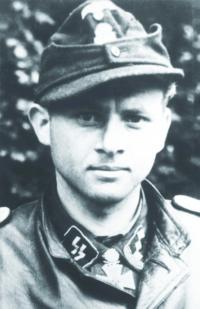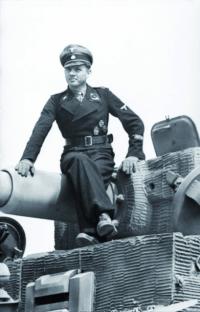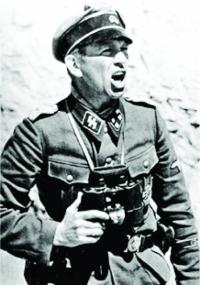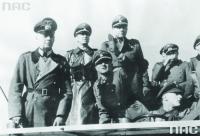
Tanker ace Michael Wittman wearing Knight’s Cross with Swords and Oak Leaves.

Michael Wittman one month prior to Operation Overlord, wearing Knight’s Cross with Oak Leave s and Iron Cross.

Panzermeyer

Field Marshals Gerd von Rundsted (lt) & Erwin Rommel.

L-R, Field Marshal Gerd von Rundstedt, Kurt Meyer, Sepp Dietrich (lt. hand raised) & Fritz Witt.
THIS WEEK, 70 years ago, Commonwealth forces were still trying to capture Caen. Caen is a 1000 year old city located 9.3 miles from the English Channel in Normandy, France, and is the burial place of William the Conqueror. On D-Day, it had been one of the objectives of the British. A month later, it was still one of their objectives. Today, it has a population of 115,000 and houses a D-Day museum. The city is strategically situated astride a major crossroads and located on the Orne River.
Fortunately for the Allies, and for the Commonwealth Forces in particular, the German response to the invasion wasn’t as quick, decisive and powerful as it could, and should, have been. There were three reasons for this. The Germans were unsure whether Normandy was the primary target or a diversion, with the real target being the Pas-de-Calais, where the English Channel was the narrowest. For that reason an army of 200,000 - Fifteenth Army, commanded by Hans von Salmuth - stayed there, rather than moving into Normandy.
The second reason was the disagreement between the senior officers in the West as to how best to respond to the invasion. Field Marshal Gerd von Rundstedt, Commander-in-Chief, Wehrmacht West and General Baron Leo Geyr von Schweppenburg, Commander-in-Chief, Panzergruppe West, advocated keeping the armor in reserve, sucking the Allies in, surrounding them and then annihilating them, as was done in 1939 in Poland, 1940 in France and 1941 and 1942 in the Soviet Union. However, as Field Marshal Erwin Rommel, Commander-in-Chief, Coastal Defenses, noted, during those campaigns, the Luftwaffe had controlled the sky. In the coming campaign, he knew that the Allies would totally dominate the air, making daylight movement all but impossible, and that therefore ALL units should be on the beaches to meet the invaders. He believed that defeating the invasion on the beaches was crucial and this was their only chance to defeat it. Because of the overwhelming materiel superiority of the Allies, once ashore, the Allies would overwhelm the Germans. Field Marshal von Rundstedt was the Wehrmacht’s senior field commander, and had successfully advocated for the implementation of General Eric von Manstein’s plan for the brilliantly successful invasion of France. On the other hand, Field Marshal Rommel had had his share of success, and failure, in North Africa, and had dealt with Allied air superiority. It is easy to understand der Führer’s difficulty in coming to a decision. He tried to split the baby by maintaining control of most of the armor, but placing it too far from the coast to be able to help, quickly.
The third reason was that Field Marshal Rommel was correct. It was virtually impossible for the Germans to move anything during the day - armor, men, fuel, food, supplies. Consequently, movement had to occur at night. After a few nights, the men were exhausted.
The closest German armor was the 21st Panzer Division, commanded by Edgar Feuchtinger. After it finally received orders, it counterattacked and drove a wedge between the 3rd British Division, commanded by Tom Rennie, on Sword Beach and 3rd Canadian Division, commanded by Rod Keller, on Juno Beach. But, unsupported, it couldn’t hold, especially in the face of the Royal Navy’s 15-inch guns on its battleships.
Once the Germans realized what was happening, General von Schweppenburg ordered the powerful I SS Panzerkorps, commanded by Josef “Sepp” Dietrich, to attack the Commonwealth forces near Caen. The Panzerkorps consisted of the SS Liebstandarte Adolf Hitler Panzer, the SS Hitlerjugend Panzer, the Panzer Lehr and SS Götz von Berlichingen Panzergrenadier Divisions, which were commanded by Theodor Wisch, Fritz Witt, Fritz Bayerlein and Werner Ostendorff.
Lending power to the Panzerkorps was the SS Heavy Panzer Battalion, with 45 Tiger tanks, commanded by Obersturmbannführer Heinz von Westernhagen. The Germans had consolidated these massive tanks - almost twice the weight of a Sherman - into separate battalions. The Tiger’s 88 could destroy a Sherman at distances of 1.5 - 2 miles, while the Sherman could not penetrate the Tiger’s frontal armor at any distance.
At 2:30 P.M., on June 6, the Hitlerjugend Division finally began to move toward the beaches from its base near Paris. The first elements arrived at Caen at 10:00 P.M. At 10:00 A.M., on June 7, the 25th Panzergrenadier Regiment of the Hitlerjugend Division, commanded by Kurt (Panzer) Meyer, arrived at Caen. He was ordered to attack the Canadians and responded that, “We will throw them back into the sea like little fishes!” However, Panzermeyer, didn’t count on the complete domination of the air, and the naval barrage, that he encountered when approaching the beaches. Both the Canadians and the SS killed each other’s prisoners. It is not known who started it, but Panzermeyer was charged and convicted of it, after the war.
The next day General Bayerlein’s elite Panzer Lehr arrived on the scene. It was elite because it was composed of former tank instructors.
On June 10, The II SS Panzerkorps, commanded by Paul Hauser, was ordered to move toward Caen. Because of the travel difficulties caused by the Allied air forces, it did not arrive until June 26. The II SS Panzerkorps consisted of the SS Hohenstaufen Panzer Division commanded by Wilhelm Bittrich and the SS Frundsberg Panzer Division, commanded by Heinz Harmel. Three days after arrival, Hauser was promoted and Bittrich assumed command of the Corps. Thomas Müller took command of Hohenstaufen.
Late on June 12, the Tigers arrived on the scene, just as the British 7th Armoured Division (“The Desert Rats”) was approaching the French village of Villers-Bocage, on its way to outflank the Germans defending Caen. The next morning, as the British entered the village, they encountered Lt. Michael Wittmann and his company of four Tiger tanks. Having destroyed 119 Soviet tanks on the Eastern Front, Wittmann was already a tanker “ace” and bearer of the Knight’s Cross with Oak Leaves. At about 9:00 A.M., Wittmann found a column of British Cromwell and Sherman Firefly tanks. He first destroyed the last two in the column. By the end of the morning, Wittmann’s tank, alone, had destroyed the following: six Cromwell tanks; three Sherman tanks; three Stuart tanks; and several half-tracks, troop-carriers and Bren gun carriers. The Desert Rats, who had earned that sobriquet in North Africa, had been stopped, and Caen was still the British objective. For his work that day, der Führer personally awarded Wittmann the Swords to his Knight’s Cross.
Naval gunfire killed the Hitlerjugend ‘s commander, Fritz Witt, on June 14. Panzermeyer was promoted to division commander, making him the youngest division commander in the war.
By June 18, Allied strength, in Normandy, stood at 500,000, with 77,000 vehicles and increasing hourly. But, Caen was still the objective. On June 24, it was surrounded on three sides by Commonwealth troops that outnumbered its defenders 6 - 1 in men, 7 - 1 in tanks and 21 - 1 in artillery, to say nothing of the Allies’ complete dominance of the air. On Monday, June 26, 644 Commonwealth guns began firing at 7:30 A.M. Two days later, just as Panzermeyer’s Hitlerjugend was about to break, Seventh Army’s commander, Friedrich Dollman, ordered the II SS Panzerkorps into the breach, and committed suicide. By the end of June, the Germans had suffered 62,000 casualties and the Commonwealth 23,000.
On July 1, having concluded that Field Marshal Rommel had been correct, Field Marshal von Rundstedt requested, “...immediate permission to...” withdraw from Caen, which permission was denied. Seething, the old Field Marshal called Field Marshal Wilhelm Keitel, at headquarters in Berlin, and demanded that the order be rescinded, telling him, “If you doubt what we are doing, get up here and take over this shambles yourself!” When Field Marshal Keitel began wailing, “What shall we do? ,” Field Marshal von Rundstedt snarled into the phone, “Make peace, you fools! What else can you do! ,” and slammed down the receiver. He was relieved the next day, and replaced by Field Marshal Günther von Kluge.
On July 7, the British fired more than 80,000 shells into Caen and that night, the RAF dropped 2000 tons of bombs on the city. Instead of Germans, the bombs and shells killed 5000 French civilians. When the British and Canadians began their offensive, the next day, they couldn’t believe the ferocity of the defense presented by Panzermeyer’s teenagers. Later that day, Panzermeyer was given permission to withdraw to the southern bank of the Orne River, leaving the center of the city to the Commonwealth forces. So, on July 9, the Commonwealth forces occupied approximately half of what had been their objective on D-Day.
The U.S. Eighth and Ninth Air Forces and the RAF sent 1,021 medium and heavy bombers against the German positions in the early morning of July 18. Monty then sent the 7th, 11th and Guards Armored, Divisions against the Germans on the other side of the river. After three days, the infantry occupied the rest of the city. Finally, the D-Day objective was secured! The cost? In those three days, Commonwealth forces lost 469 tanks with 3500 casualties. The Germans lost 75 armored fighting vehicles with 4500 casualties.
By now, Panzermeyer’s Hitlerjugend Division had lost 70 percent of its effectiveness.
NEXT WEEK: ST. LÔ
Mr. Wimbrow writes from Ocean City, Maryland, where he practices law representing those persons accused of criminal and traffic offenses, and those persons who have suffered a personal injury through no fault of their own. Mr. Wimbrow can be contacted at
wimbrowlaw@gmail.com.
«Go back to the previous page.




